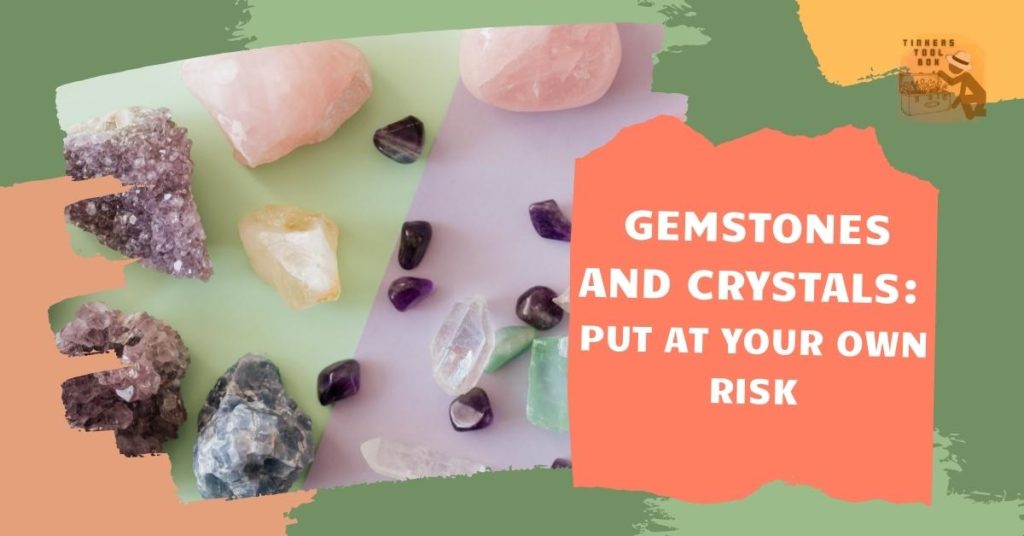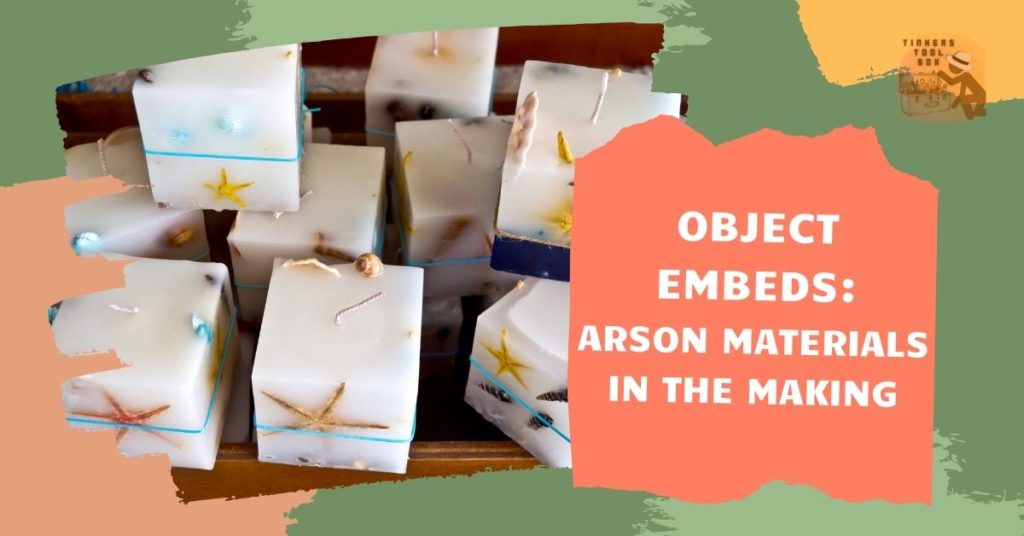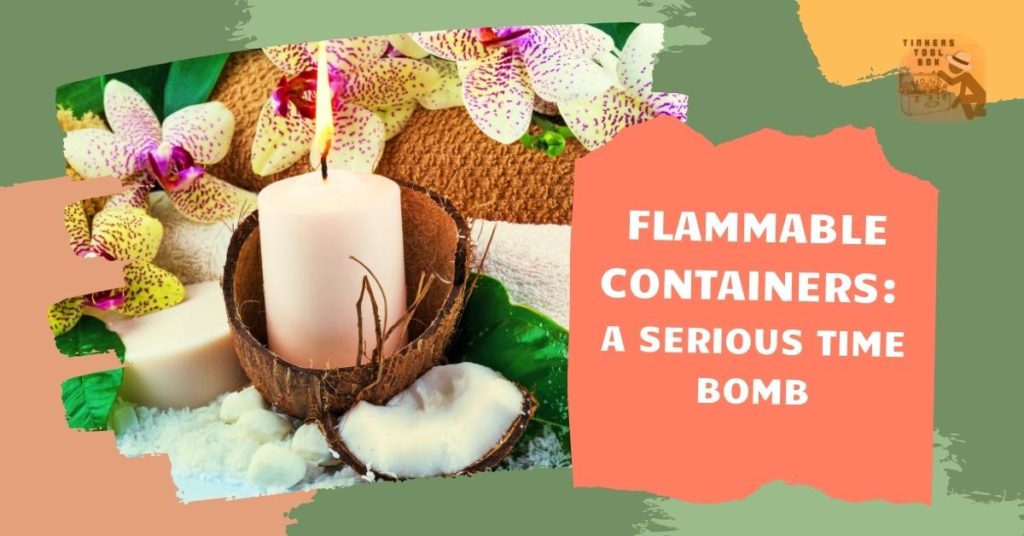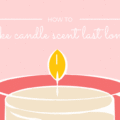Candle-making is a fun activity that inspires imagination and creativity, from the wax colors, patterns, layering, and even the containers where you pour the melted wax into to create that perfect shape that will be an integral part of your candle’s overall appearance. However, in hopes of making your candles look more aesthetically pleasing, it might lead you to put certain materials that are not allowed to be included in a candle-making session. These materials should never be a part of any candle-making project for various reasons.
Some of the things you should never use in candle-making include pigment-based dyes such as crayons, food dyes, and mica powder, real perfumes, titanium dioxide, some crystals and gemstones, flammable embeds, and flammable containers.
In this article, you will learn the different things you should never use in candle-making, including why, for safety, aesthetics, or other reasons. I will also add some candle-friendly alternatives, which can add the same value compared to the prohibited materials. Lastly, you will know why candle-making should never be the place for those materials in this article.
Crayon Waxes: Colorful But Very Dangerous

I know that you want your candles to look aesthetically pleasing, creative, and appealing to the eyes, as you are making those either for gifting purposes for your friends and family or for business purposes as you want to sell them to other people, either for gifting purposes or personal consumption. Colors can really make your candles look gorgeous, even without lighting them on.
However, you should never consider using crayon waxes to add that much-needed pop of color to your candles, whether it is made with soy, paraffin wax, or any other kind of material. Yes, crayons are waxes, and they are colorful. Still, you should never use them in coloring your candles. Even sticking a crayon on your candle can be potentially dangerous not only to you but also to those who will use it in the future.
This is because crayons and candles have different materials in waxes. Candles can be made in soy or paraffin wax or other wax materials, but crayons are made of food-grade wax.
Crayon makers have used food-grade wax because there are chances that kids will eat crayons out of curiosity. Since it is a food-grade quality ingredient, they will not have much damage compared to when they accidentally eat your paraffin wax candle lying around the table on one Thanksgiving dinner.
Thus, because they are not the same kind of wax, you cannot expect your candle to be of high quality when you use crayons in the mix. The quality can be compromised in the form of snuffing out your wick, and it will make your candle unusable because of that.
Also, crayons are pigment-based, and you should never use any pigment-based dyes and coloring agents in making your candles. This next header would tell you why, in much detail.
Pigment-Based Colors: It Can Snuff Your Wick Out Easily

Pigments are typically inorganic, meaning they do not dissolve in a substance or are insoluble in a substance, depending on the circumstance. They do not color a substance because they are mixed with it; instead, they are derived from individual colored particles dispersed throughout the substance.
Most of the time, a dye is an organic compound that dissolves in an organic compound that is soluble in the dye solution. They do this by utilizing the wonders of chemistry to enhance the color of whatever they are in.
When compared to dye, the pigment has the consistency of a powder, while dye has the consistency of the liquid. Candle manufacturers incorporate dye into their products to keep the wick from becoming clogged. Remember that a wick serves as a conduit for the wax to travel from the wick to the flame.
It is basically the same underlying principle. Wicks are specifically designed to transport wax blends. They are not intended to transport large chunks of solid material that have not been completely dissolved in the wax. Unfortunately, there is simply not enough space in the wick to accommodate everyone.
Since pigments do not dissolve in wax, they act as large rocks in the candle’s interior because they do not dissolve in wax. Regardless of how beautifully they color the candle, they will completely clog the wick and sabotage the whole project. They become entangled in the wick’s weaving, preventing sufficient melted wax from passing through to keep the flame burning. All candles made in this manner will eventually go out of service.
Oil-soluble dyes also work well with wax blends. Nearly every supply company carries either liquid or block dyes suitable for use with any commercial candle waxes. They are intended to work in concert rather than in competition with one another. They are the only option for full-blend wax coloring, which is currently unavailable.
Crayons are examples of pigment-based coloring agents, so you should never consider using any crayon waxes or any pigment-based colors in any of your candle-making projects to avoid lowering the quality of the candles. Remember that the materials and ingredients in candle-making projects are known to be expensive, so do not waste your money in incorporating materials that will significantly affect your final products negatively.
Titanium Dioxide: There’s No Pure White Candles

Since soy, for example, is an off-white, creamy color, white candle dye is not readily available in addition to the natural whiteness found in paraffin or palm. Even though white candle dye is not readily available outside of the natural whiteness found in paraffin or palm, white candle dye is not readily available in addition to the natural whiteness found in paraffin or palm.
Titanium dioxide is a coloring agent that can be found in various products and is used to color them. It is a white colorant that occurs naturally in the environment and can be used in various applications. This colorant can be used both as a stand-alone colorant and as an ingredient in various other formulations.
Since it is only available as a pigment when used as a coloring agent, it is ineffective when used as a fragrance ingredient in regular candles. In addition to titanium dioxide, most other white dyes available for candle-making are formulated with titanium dioxide as the primary active ingredient in the formulation.
The use of paraffin wax or a small amount of stearic acid to “whiten” a candle blend is common among candle makers, but this is not the same as coloring it with dye. For the most part, white candles must be made with white wax, such as paraffin or palm oil, to be effective.
Mica Powder: Can Only Be Used in Decorative Candles

There is actually nothing wrong with mica, aside from its pigments that clog wicks. However, unlike crayons, mica powder can be used as a decorative outside coloring rather than a blended color, making it a good alternative to paint. You can make a candle without any color, harden it and then decorate the outside with mica powder that has been painted on it, for example.
This does not ensure a clean burn because the powder can still potentially enter the melt pool and clog the wick. Still, it does reduce the likelihood of problems occurring during the burn. The majority of candle designs that incorporate mica powder are purely decorative and are not intended to be used as a flame.
Real Perfume: Turns Your Candles into Ticking Time-Bombs

The temptation to simply pour a few drops of real perfume or cologne into the wax melts instead of searching for the perfect fragrance for candle making may be strong if you cannot find the perfect fragrance. Obviously, this is a bad idea that can result in a variety of issues.
The fact that it can cause a significant fire hazard is just the beginning. Aromatic fragrances and colognes are typically made with alcohol, which is extremely flammable when it is ignited. Almost any type of candle that contains pure perfume is a fire hazard that can be ignited with the push of a switch.
In addition, it can create complications when working with wax. It is possible to use fragrance oils in conjunction with melted wax without them blending seamlessly and without any effect on the way the candle wax is set if used in the proper amounts. Under their presence in the wax, flavorings can cause it to become brittle, chunky, and discolored.
The scent will never last for an extended period, as a final point to mention. Even though it is possible to make candles that contain real perfume rather than fragrance oils, the scent of the candles will fade very quickly due to the alcohol base used in their manufacture. Since scented oils burn more slowly, they allow candles to burn for significantly longer periods.
You may enjoy experimenting with different scents and try making your own perfume imitation fragrance. Find a detailed description of the scent itself, which will provide you with the fragrance notes. Then experiment with different combinations of scented oils to see if you can find something similar to the original scent.
Many perfume houses offer fragrance oil versions of their scents for those who want to use them on candles, soaps, body care, hair care products, and more, which is much better than pouring a bottle of your favorite Jo Malone perfume into your soy candle mix.
Also, many fragrance oil suppliers can host these perfume oils, which is much safer to use. You just have to ask your friendly supplier for new scents, and they might have the exact scent you are looking for in your candle-making projects.
Gemstones and Crystals: Put at Your Own Risk

One of the most popular types of candle-making projects nowadays is gemstone candles. These are candles with gemstones and crystals inside, so you can anticipate these coming out once your candle has melted. Crystals have many different healing properties and energy cleansing characteristics, so it is only typical to see these two working hand in hand in mindfulness meditation.
However, always keep in mind that you cannot just put any crystal you want in your candle-making projects. Any size gem will suffice, as long as it is small enough to fit inside the candle you create. You can even use a candle to hold a collection of smaller gems.
Certain gemstones are sensitive to heat, so you should avoid using them in candle arrangements. Citrine, for example, has been reported to fade when heated, according to the International Gem Society.
Some materials, which are commonly referred to as gems, are actually organic in origin and can react negatively to heat due to this. Peridot, malachite, and garnet are among the gemstones to avoid. Opal, another popular choice for gemstones in candles, contains trace amounts of water and can fracture when heated, so it should be handled carefully. The International Gem Society (IGS) specifically advises against heating coral, ivory, or pearls.
Artificial gemstones should be avoided unless they have been specifically created for this purpose. It is possible that they are chemically distinct from their genuine counterparts and do not perform well in high temperatures.
Before putting any crystals or gemstones into your candle mixes, always check if your desired stones or crystals can last the heat from the candles. Find alternatives that will serve the same purpose while not making your candles a hazard to anyone using them.
Object Embeds: Arson Materials in the Making

One of the most popular candle-making trends on Pinterest and YouTube among candle-makers is candles embedding objects inside the candles. Many people do it for the element of surprise, without knowing that it can potentially ruin you and your properties once used wrongly.
The majority of crafts allow you to express your individuality through materials, colors, and approaches. On the other hand, Candles are not quite as adaptable, at least not in all situations. If you think about it, every non-melt candle is literally on fire while it is in operation. The amount of “creativity” that can be achieved by modifying the way most candles work is severely limited as a result. Embeds are well-known in the industry.
If you are unfamiliar with embedding, it refers to any type of decorative item added to a candle in addition to the standard wax blend. A marble or a ring may be embedded by a candle maker, and some candle makers may embed literal wax melts near the top of the candle.
There are clear limitations to this concept, no matter how far you take it. Any embeds that are not heat resistant, as well as anything flammable, should not be used in any candle under any circumstances. Wax is acceptable. In fact, in many areas, wax embeds are the only type of embed that is considered acceptable.
While embeds are aesthetically pleasing and add a neat, artistic touch to a candle, they are not typically something that makes insurance companies smile. Obtaining candle insurance can be difficult enough as it is, but altering the expected behavior of a candle with materials that are not typically used in candle making can raise a few eyebrows.
Flammable Containers: A Serious Time Bomb

I know that candle-making can inspire you to try and be adventurous in your decoration steps. Still, there are times that it might compromise your safety and those who will use your candles in the long run. One frequently broken rule is that you must make your candles in flame and fire-resistant containers.
This appears to be a fairly obvious rule to follow, but it is broken consistently. Anything that cannot be used to hold an open flame, including birch bark bowls, coconut shells, and plastic margarita glasses, is prohibited from being used as a candle.
For example, using flower pots or other porous ceramic containers to hold candles is another widely reported example of this practice. Terra cotta, for example, is a porous material that can absorb the wax. According to the possibility of turning into a giant wick, an enormous flame could be seen rising along the rim of the flower container.
Is it physically possible to do so? Yes. Is it a possibility? No. For the wax absorbed into the pot to burst into flames, the temperature of the wax would have to be extremely high. Using a decoupage medium such as Mod-Podge to coat porous ceramic containers before making the candle is highly recommended.
And, once again, never make a candle in a container that has the potential to catch fire. It makes no difference how beautiful it appears or how confident you are that the flame will never even come close to the edge of the container.
Enjoy Candle-Making as a Safe and Healing Activity
This article is not to discourage you with anything when it comes to candle-making. I know that art can never be restrained. Still, you should always remember that safety should always be a top priority for you in any candle-making project you have. No one is stopping you from trying many ways to make candles apart from the traditional methods. Still, you should always exercise safe candle-making to create top-quality candles without you or your recipients getting injured for some reason. Stay safe and have fun making candles you will surely love!















